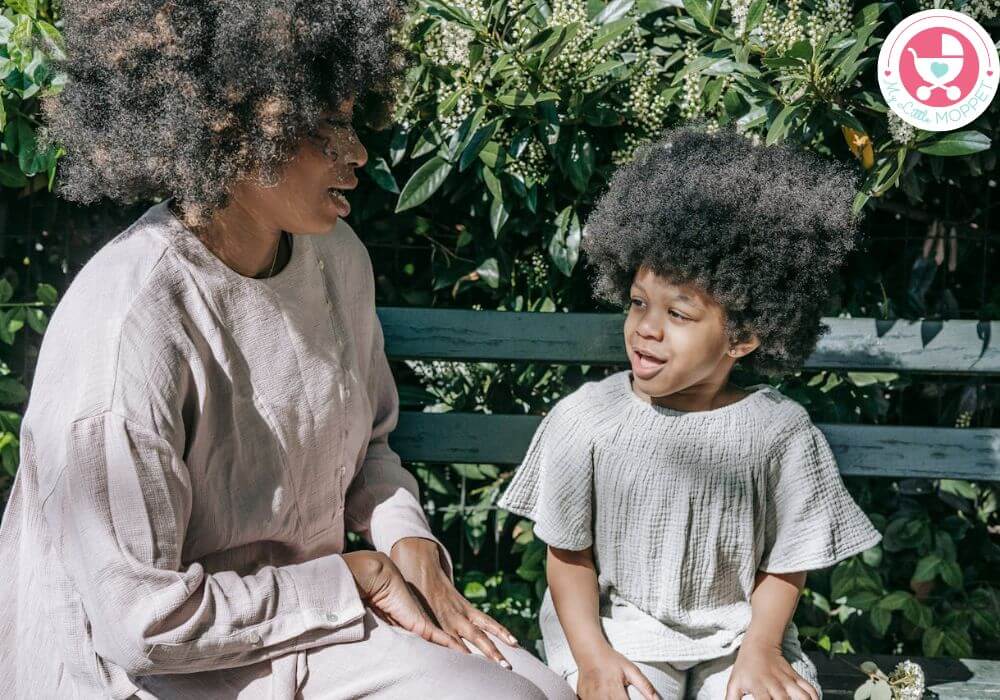Here’s everything you need to know about stuttering in children – what it is, why it happens and how you can help them manage it.
What do actresses Nicole Kidman and Emily Blunt, ‘Mr. Bean’ Rowan Atkinson, singers Elvis Presley and Ed Sheeran, actor Hrithik Roshan, golfer Tiger Woods, writer Lewis Carroll, U.S President Joe Biden and British King George VI have in common?
Yes, they’re all famous people, but they’re famous people who’ve conquered stuttering!
Parents who notice their child stuttering may be confused about what to do. Is a certain level of stuttering normal? When should I worry? How can I help my child?
With International Stuttering Day coming up on 22nd October, we think it’s the perfect time to answer all these questions about stuttering in children.

Stuttering is a kind of speech disorder that affects the normal rhythm and flow of speech. This can appear as pauses, repetition, or unintended sounds during speaking. These disruptions in speech are called ‘disfluencies’, and as a result, stuttering is also referred to as stammering or childhood-onset fluency disorder. Stuttering comes under the category of speech impediments in childhood.
What causes stuttering?

The exact cause of stuttering is still unknown, although problems with speech motor control and coordination may be responsible.
Speech development is a complex process that involves multiple parts of the body. Talking requires communication between different areas of the brain, as well as between the brain and muscles in the face, throat, chest and abdomen. All these processes need to work together in perfect sync for a child to be able to speak clearly.
Stuttering or stammering happens due to a lack of coordination in any part of this system. In the early years of a child’s life, this lack of coordination is normal, as the neural pathways for speech are still being formed. Therefore, it is natural for almost 80% of kids between the ages of 2 and 5 to have some stuttering. This usually goes away on its own.
Here are some factors that make a child more vulnerable to stuttering than others:
- Having a family history of stuttering or other speech/language disorders
- Having other developmental conditions like ADHD or autism
- Being male
- Extreme stress
- Anxiety or depression, particularly in children between the ages of 12 and 17
Signs of Stuttering in Children

- Repeating entire phrases, like “Where is … where is Mommy?”
- Repeating words, like “Where… where is Mommy?”
- Repeating sounds or the first syllable of a word, like W-W-W-Where
- Drawing out or prolonging certain sounds, like SSSweets
- Interjecting sounds like ‘um’ or ‘uh’ in the middle of speaking
- Stressing or emphasizing a word or part of a word
- Having difficulty starting a sentence
- Pausing a lot mid-word or mid-sentence
- Stopping during speech with the mouth open but no sound
- Being out of breath while speaking
- Switching words – moving to another word when getting stuck on one
- Tightness in the facial muscles or upper body when speaking
- Blinking eyes, trembling lips or clenched fists
- Unusual facial spasms or tics when talking
- Being anxious about having to speak with others
Children with a stuttering disorder may find that it worsens under stress or during excitement, while it seems to disappear during activities like singing or reading aloud.
Types of Stuttering

Developmental stuttering
This is the most common type of stuttering in children, also considered the ‘normal’ stuttering. This occurs in children between the ages of 2 and 5, while their speech is still developing. This kind of stuttering generally goes away on its own and requires no intervention.
Neurogenic stuttering
This kind of stuttering happens when there is a problem in the communication between the brain and the muscles involved in speech. It often occurs after any kind of brain injury, including strokes.
Psychogenic stuttering
This is a kind of stuttering that occurs after the child has experienced some kind of emotional trauma or distress. This applies when the child did not have any stuttering previously, but began after a traumatic event.
Treatment for Stuttering in Children

While most children overcome developmental stuttering by the age of five, sometimes it can persist, which means it’s a sign of an abnormality. Here are some more signs to look out for:
- Stuttering that lasts for more than 6 months
- Tight facial muscles or grimaces during speech
- Avoiding certain sounds, words or phrases
- A fear of talking or avoidance of situations that require speech
- Problems in school or social life
If you notice any of these problems, you should see your child’s pediatrician, who will then refer you to a certified speech-language pathologist. An SLP is a professional who is qualified to diagnose and treat speech problems like stuttering in children.
Stuttering cannot be cured by medications, but there are other treatment strategies that can help. The strategy you choose will depend on your child’s age and the severity of stuttering.
1. Speech therapy
Speech therapy encourages kids to slow down and pay attention to when they stutter. As they learn to overcome their disfluencies, they can gradually increase their talking speed till they reach a normal pattern.
2. Speech restructuring programs
These programs are a kind of speech therapy that makes use of fluency shaping to improve stuttering in children. This is done by extending vowel sounds, reducing speed and improving airflow. One example is the Lidcombe Program, which is ideal for young children.
3. Electronic devices
Some electronic devices can help improve speech problems like stuttering by offering feedback or forcing the speaker to slow down. These devices can be small enough to wear, making them a great choice for on-the-go speech therapy.
4. Cognitive behavioral therapy
Also known as CBT, this kind of therapy is great for stuttering in children arising from traumatic events. It uses psychotherapy that helps children notice their thought patterns and reduce any stress or anxiety that may be causing the stammering.
5. Parent-child interaction
All the therapies mentioned above work best when accompanied by sufficient parent-child interaction at home. Parental support is a key factor in determining the success of any treatment for stuttering in children.
Please remember that the earlier you start treating stuttering in children, the better the outcome will be. It can become progressively more difficult to handle as kids grow older.
Tips to Help Stuttering in Children

- Set aside distraction-free time to speak with your child every day
- Engage your child in conversation about topics of their interest
- Keep conversation light-hearted, fun and free
- Don’t interrupt when your child is speaking
- Avoid asking them to start over ‘correctly’
- Listen intently when your child is talking
- Speak slowly and clearly, so your child tends to mirror the same
- Don’t rush in to correct your child when they’re pausing
- Don’t focus on mistakes
- Offer lots of praise for even small improvements
- Never criticize your child about their speech issues
- Build their self-esteem by focusing on all the things they’re good at
- Let them know that they don’t need to hide their stuttering
- Let stuttering be a topic you can discuss openly in your home
- Create a calm and stress-free environment at home
- Establish routines that have plenty of buffer time so your child is not always feeling rushed
- Talk to your child’s teachers and educate them too
- Make sure you care for your child’s mental health and seek therapy if necessary
Books about Stuttering for Children

While you don’t want your child’s identity to be all about their stuttering, you don’t want to ignore it either. Letting stuttering go untreated can lead to complications like lower self-esteem, below-average academic performance and poor communication skills. All these can prevent them from seeking out good opportunities and not living up to their full potential.
Instead, help them manage their stuttering and let them know that they have nothing to be ashamed of. Stuttering in children is something that can be overcome with the right support and guidance, especially from parents.

References:
Buy Healthy Nutritious Baby, Toddler food made by our own Doctor Mom !
Disclaimer: This content was automatically imported from a third-party source via RSS feed. The original source is: https://www.mylittlemoppet.com/stuttering-in-children/. xn--babytilbehr-pgb.com does not claim ownership of this content. All rights remain with the original publisher.




